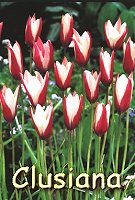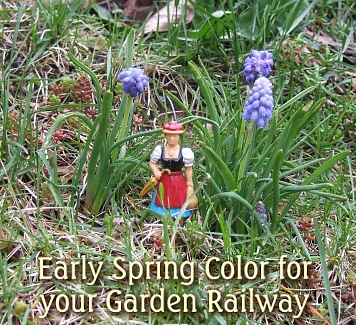
|
Okay, I'm a sucker for Spring (see the Herbert picture-poem at the end of this page if you don't believe me).
By mid-March, I'm prowling the garden centers, inspecting my perennial beds and ornamentals to see how things wintered over and otherwise making a nuisance of myself outside long before I can start getting any practical work done out-of-doors.
It probably helps that we've invested in quite a few early spring flowers over the years. In my zone 5 - 5.5 yard, the daffodils and narcissus actually break the ground in January, then stay about an inch high until it starts to warm up. By late March or early April, the borders of our front yard are a riot of yellow, off-white, and in-between flowers. And that's not all. Just before the daffodils open, the crocus peak. Then, when the yellow daffodils have peaked and the pale narcissus are coming on, the hyacinth and tulips show their colors. I feel like the narrator of the Herbert poem at the bottom of this page, incredibly and inexplicably renewed, except, of course, that every year it's harder to get up from weeding my flowerbeds.
 In the same few weeks that my front yard is blaring color, my garden railroad is "greening up" bravely, due largely to use of many plants that keep at least some of their color over the winter - mostly conifers and ground-hugging thymes and sedums. But aside from the occasional dandelion and the miniature tulips I'll discuss further down in the chapter, most of my garden railroad's color doesn't come in until mid-June when the yarrows, finger geraniums, and sedums begin to peak. Still, there's no real reason, my garden railroad can't be as colorful in early April as the rest of our yard. And it is possible to incorporate that color without making my railroad look like a flower garden the rest of the warm season. In the same few weeks that my front yard is blaring color, my garden railroad is "greening up" bravely, due largely to use of many plants that keep at least some of their color over the winter - mostly conifers and ground-hugging thymes and sedums. But aside from the occasional dandelion and the miniature tulips I'll discuss further down in the chapter, most of my garden railroad's color doesn't come in until mid-June when the yarrows, finger geraniums, and sedums begin to peak. Still, there's no real reason, my garden railroad can't be as colorful in early April as the rest of our yard. And it is possible to incorporate that color without making my railroad look like a flower garden the rest of the warm season.
90% of the plants on my railroad have been selected because they look like miniature trees and bushes. Or, in the case of some yarrows that I let flower, they can be trimmed to look like miniatures and bushes. In the early spring, though, I'm not as addicted to a "realistic look" as I get later on, when I've hauled out my buildings and bigger trains. So, for me, the ideal "early color" plant for a garden railroad includes the following characteristics:
- It should make a splash of color some time between March 1 and May 1.
- It should be small enough overall not to overwhelm my trains and accessories or even my other plants (although the leaves and flowers can be "way" out of scale compared to what I usually find acceptable)
- It should require little or no maintenance once it is planted (the rule for all of my perennials.)
- It should "hold its own" or spread slowly from year to year (and not require replanting every so often as some spring bulb plants do).
- The foliage that remains after the flower is gone should disappear by early summer or at least be mostly "in scale" with the rest of my garden.
|
|
 |
This article is mostly a list of the plants I've found that fulfill these categories for my zone 5 garden railroad. Some I have tried on the railroad, and others I've tried in the garden and plan to use on my railroad. Chances are you have already used some of these and many other plants besides - please let me know what works for you, and I'll try it out and write it up when I get the chance.
Some plants discussed in this article are:
When To Buy These Plants
 Most of these plants are best spread by bulb, which means that if you know what you want, you can order them in the summer and put them in the ground in the fall. That's the only way to buy crocus, I think. That said, you occasionally see daffodils and other spring-blooming bulbs for sale in pots in the spring. If you see one of the flowers on this page (or a close relation) blooming in a pot in the spring, and you like the look of it, by all means, go for it. As long as you keep the bulbs alive long enough to get into the ground before next winter, it should make a nice addition to your garden. Too bad I didn't think far enough ahead to write this article last year, so you could have all bought the bulbs you needed by now. Oh, well, now is the time to plan and observe. Most of these plants are best spread by bulb, which means that if you know what you want, you can order them in the summer and put them in the ground in the fall. That's the only way to buy crocus, I think. That said, you occasionally see daffodils and other spring-blooming bulbs for sale in pots in the spring. If you see one of the flowers on this page (or a close relation) blooming in a pot in the spring, and you like the look of it, by all means, go for it. As long as you keep the bulbs alive long enough to get into the ground before next winter, it should make a nice addition to your garden. Too bad I didn't think far enough ahead to write this article last year, so you could have all bought the bulbs you needed by now. Oh, well, now is the time to plan and observe.
  An avid fan of longtime Garden Railways garden editor Barbara Abler, I wrote down the name of a miniature tulip she recommended and shopped carefully for it. It was the Clusiana a dainty, red and white early bloomer shown here in a bulb catalog illustration. The package I bought said "Clusiana Peppermint," so that should have been foolproof, don't you think? But when my tulips came up, they were red and yellow. I'm inclined to think they are Clusiana Cynthia, shown in another bulb catalog illustration. Whatever they are, they're a fun addition to my railroad. The leaves are very slender, so that even when the plants are flourishing, there's nothing overwhelming about the greenery. Like most tulips, though, the leaves only seem to last a few weeks longer than the blooms, so they are well out of the way before my summer plants take over the same corner. An avid fan of longtime Garden Railways garden editor Barbara Abler, I wrote down the name of a miniature tulip she recommended and shopped carefully for it. It was the Clusiana a dainty, red and white early bloomer shown here in a bulb catalog illustration. The package I bought said "Clusiana Peppermint," so that should have been foolproof, don't you think? But when my tulips came up, they were red and yellow. I'm inclined to think they are Clusiana Cynthia, shown in another bulb catalog illustration. Whatever they are, they're a fun addition to my railroad. The leaves are very slender, so that even when the plants are flourishing, there's nothing overwhelming about the greenery. Like most tulips, though, the leaves only seem to last a few weeks longer than the blooms, so they are well out of the way before my summer plants take over the same corner.
|
  Clusiana have one other interesting characteristic: they seem to spread by seed, although the bulbs themselves do not seem to last longer than a few seasons. So the clump of Clusiana Cynthia in my garden has migrated from where I first planted it, both downhill and uphill, though few remain where they started out. In fact most of them are growing in a bank of Silveredge hosta, which gives the incongruous appearance that the hosta is blooming little red and yellow flowers. Clusiana have one other interesting characteristic: they seem to spread by seed, although the bulbs themselves do not seem to last longer than a few seasons. So the clump of Clusiana Cynthia in my garden has migrated from where I first planted it, both downhill and uphill, though few remain where they started out. In fact most of them are growing in a bank of Silveredge hosta, which gives the incongruous appearance that the hosta is blooming little red and yellow flowers.
My Clusiana is not in a pretty little clump anymore, but it adds bright color to a slope that is otherwise somewhat dingy in the early spring. I provided a photo of Helga next to one plant that's gone completely off on its own, so you can get an idea of size. Again, Helga is just under three inches tall.
|
|

|
|
I'm told that in central Europe this flower is a "weed," which probably explains why I can usually keep it going, although it doesn't quite flourish in our yard. Grape Hyacinth belongs to the genus Muscari. They are perennials with grasslike leaves that seem to disappear into the lawn or flowerbed as soon as the flowers are gone. Most of the Grape Hyacinth in our yard was either there when we moved in, came in starts from my sister, or was puchased as "generic" Grape Hyacinth during a Springfield Children's Chorus fund raiser. These plants vary between 4" and 8" tall, with indigo or purple berries. In spite of their obvious application, I didn't start planting them near my railroad until last fall - generally we've kept them coralled near the crocus plantings by our driveway and back steps. The first photo of them shows some I just planted in the middle of last winter when we got some bulbs cheap; chances are they'll be higher next year when they've had a chance to properly root. (In case you wonder, the resin buildings shown are left out all winter after I take my "good" buildings in just so the railroad doesn't look totally abandoned. You could consider this little house Helga's "winter home.")
  In addition to the "generic" Grape Hyacinth, we did purchase some Valerie Finnis Muscari last year. This is a pale bluish purple, and a tad taller than the "generic" plants. It is shown first in a bulb company catalog photo, then near Helga, so you can get the idea of its relative size. In addition to the "generic" Grape Hyacinth, we did purchase some Valerie Finnis Muscari last year. This is a pale bluish purple, and a tad taller than the "generic" plants. It is shown first in a bulb company catalog photo, then near Helga, so you can get the idea of its relative size.
My experience with most Grape Hyacinth is that they generally stay where you put them from year to year, but they haven't spread out much for me. In fact the Valerie Finnis have thinned out. When researching this little plant, I saw some beautiful gardens where scores of Grape Hyacinth were planted closely together to create something that looked like a thick indigo carpet when it was in bloom. But the only way I'll probably get them to look like that on my railroad is by investing in scores of bulbs - they show very few signs of wanting to "fill in" on their own as some other plants do.
|

|
|
|
 Of course you can't talk about early spring color in Zone 5 without mentioning Crocus. These are usually among the first bloomers in my garden (right after the snowdrops, which don't really count because they're taller than the plants I'm writing about here). Crocus seldom exceed 6" in height. The leaves that remain once the flowers are gone are grass-like and innocuous, like those of Grape Hyacinth. They are available in a wealth of colors, including white (sort of), yellow, blue, and purple. Of course you can't talk about early spring color in Zone 5 without mentioning Crocus. These are usually among the first bloomers in my garden (right after the snowdrops, which don't really count because they're taller than the plants I'm writing about here). Crocus seldom exceed 6" in height. The leaves that remain once the flowers are gone are grass-like and innocuous, like those of Grape Hyacinth. They are available in a wealth of colors, including white (sort of), yellow, blue, and purple.
For me, Crocus seem to do very well the first year, make a pretty good showing the second year, and begin to thin out the third year. This may have to do with our wildlife, or constitutionally poor soil, so your mileage may vary. The point is that we are continually replenishing our Crocus to keep a good spring showing. Fortunately, they don't cost much, so we consider a few new packages of Crocus every year to be a pretty good investment in near-instant gratification.
We've planted several kinds over the years, so I don't always remember which variety is which. For some reason, though, the yellow Crocus seem to hold up better over a several year period than the blue or purple Crocus - maybe they're closer to the "natural stock." Whatever the cause, several beds in which we planted a "mixed color" collection of bulbs became 90% yellow within a few years. Nowadays we mostly plant blue or purple, to retain a balance.
I'd include a photo of Helga standing next to a Crocus patch, but the Crocus had passed their bloom before I decided to write this article this year. Maybe next year. In the meantime, I have included a nice picture of Crocus coming up through the snow from one of my
sponsors. In fact, my daughter just found two bags of "jumbo daffodils" left over from last autumn that never got into the ground. Maybe it's a "sign" that it's time to give the railroad its fair share of these bright "early birds."
|

|
|
First let me explain one of the reasons I like daffodils in general. In 1986, my nephew helped me plant 18 "jumbo" daffodils in poor clay soil around a tree in the front yard of our house. In 1994 that tree came down, and we dug up the daffodil bulbs to plant them elsewhere so we could convert that part of the property back into lawn. Without any particular care on our part, that collection of daffodils had grown to over 120 bulbs. We lined one side of our property with them (the other side was already lined with narcissus from a previous owner), and helped the folks next door plant about 60 in their yard.) In other words, here is a plant that likes our soil and seems to thrive on neglect. What more could I ask for? Well they're a little to big to use on my railroad, even in early spring.
 I had never thought about putting miniature daffodils on my garden railway - in fact I had never thought about miniature daffodils - until one magically appeared in a patch of off-brand crocus two years ago in the front of our house. Charming. Then the next year it didn't make a showing as far as I could tell. Then the next year it came back, with three blooms instead of one. Now it's up to six, and three of the blooms are on one stalk, which makes me wonder if it's a variety of Tet-a-Tet, which typically grow two on a stalk. The bulb catalog photo to your right gives a pretty good sense of the color. This cluster of plants averages 5-7"tall. I have since bought two pots of Tet-a-Tets and split out the bulbs in the poor soil near my garden railroad. They did well enough this year that I may split them out again and spread them around some more. I had never thought about putting miniature daffodils on my garden railway - in fact I had never thought about miniature daffodils - until one magically appeared in a patch of off-brand crocus two years ago in the front of our house. Charming. Then the next year it didn't make a showing as far as I could tell. Then the next year it came back, with three blooms instead of one. Now it's up to six, and three of the blooms are on one stalk, which makes me wonder if it's a variety of Tet-a-Tet, which typically grow two on a stalk. The bulb catalog photo to your right gives a pretty good sense of the color. This cluster of plants averages 5-7"tall. I have since bought two pots of Tet-a-Tets and split out the bulbs in the poor soil near my garden railroad. They did well enough this year that I may split them out again and spread them around some more.
Daffodils have long slender leaves similar to, say Day Lilies, and the leaves stay for several weeks after the daffodils have lost their blooms. I've been told that, even though it's tempting to whack the daffodil leaves off as soon as the plant is out of bloom, the plant will grow better if you leave the leaves until they fall over of their own accord, usually about Memorial day in our region (Southwest Ohio, zone 5 or 5.5, depending on whether you're north or south of I-70). The smaller leaves of miniature daffodils are much less objectionable of course.
Incidentally, several bulb companies now sell miniature daffodils and grape hyacinths together in a "spring color package." It's a pretty impressive combination. I'm told that there's a garden in france where they plant a "river" of grape hyacinths surrounded by "banks" of miniature daffodils, complete with a bridge over the "river." So for a few days each spring, at least, it must be VERY impressive.
|
 |
 I don't have any of these, but our friends Diane Mann and John Le Forestier say they have had them for a while with great results. Marc Horovitz's and Pat Hayward's new book Gorgeous Garden Railways shows a nice specimen of Iris Reticulata "Harmony" on page 78. The "Harmony" cultivar has the same startling deep blue blooms as most Grape Hyacinth, with relatively unobtrusive deep green foilage that shrinks away as warmer weather arrives. According to John, the variety he owns blooms for about three days each, but they "stagger" a little so the color period is a bit longer. I don't have any of these, but our friends Diane Mann and John Le Forestier say they have had them for a while with great results. Marc Horovitz's and Pat Hayward's new book Gorgeous Garden Railways shows a nice specimen of Iris Reticulata "Harmony" on page 78. The "Harmony" cultivar has the same startling deep blue blooms as most Grape Hyacinth, with relatively unobtrusive deep green foilage that shrinks away as warmer weather arrives. According to John, the variety he owns blooms for about three days each, but they "stagger" a little so the color period is a bit longer. Conclusion
Why do I list only a few plants here? Because these are plants with which we or someone we know have had at least some measure of personal success. I didn't list about six other varieties that people "swore by" and that cost us "real money," but which made a poor showing or none at all. That said, your mileage will vary; you may have luck with plants that didn't "work out" for me or you might even have bad luck with one of the plants on this page. Even more likely, you've found other "perfect early color plants" for your garden railroad and you can't believe I overlooked them. Please let me know as much as you can and I'll research it (and try it out if I get the chance) myself.
In the meantime, please enjoy the graphic below, and have a great spring.
|
George Herbert was a seventeenth-century English poet who wrote many charming religious poems that took the shape of the things he was writing about. Note how the verses of this poem are shaped like bouquets of flowers.
For a 1.3 meg version of this "picture-poem" that you can print as a poster on your color printer, click on the image. |

|




























 Of course you can't talk about early spring color in Zone 5 without mentioning Crocus. These are usually among the first bloomers in my garden (right after the snowdrops, which don't really count because they're taller than the plants I'm writing about here). Crocus seldom exceed 6" in height. The leaves that remain once the flowers are gone are grass-like and innocuous, like those of Grape Hyacinth. They are available in a wealth of colors, including white (sort of), yellow, blue, and purple.
Of course you can't talk about early spring color in Zone 5 without mentioning Crocus. These are usually among the first bloomers in my garden (right after the snowdrops, which don't really count because they're taller than the plants I'm writing about here). Crocus seldom exceed 6" in height. The leaves that remain once the flowers are gone are grass-like and innocuous, like those of Grape Hyacinth. They are available in a wealth of colors, including white (sort of), yellow, blue, and purple.


 I don't have any of these, but our friends Diane Mann and John Le Forestier say they have had them for a while with great results. Marc Horovitz's and Pat Hayward's new book Gorgeous Garden Railways shows a nice specimen of Iris Reticulata "Harmony" on page 78. The "Harmony" cultivar has the same startling deep blue blooms as most Grape Hyacinth, with relatively unobtrusive deep green foilage that shrinks away as warmer weather arrives. According to John, the variety he owns blooms for about three days each, but they "stagger" a little so the color period is a bit longer.
I don't have any of these, but our friends Diane Mann and John Le Forestier say they have had them for a while with great results. Marc Horovitz's and Pat Hayward's new book Gorgeous Garden Railways shows a nice specimen of Iris Reticulata "Harmony" on page 78. The "Harmony" cultivar has the same startling deep blue blooms as most Grape Hyacinth, with relatively unobtrusive deep green foilage that shrinks away as warmer weather arrives. According to John, the variety he owns blooms for about three days each, but they "stagger" a little so the color period is a bit longer. 








